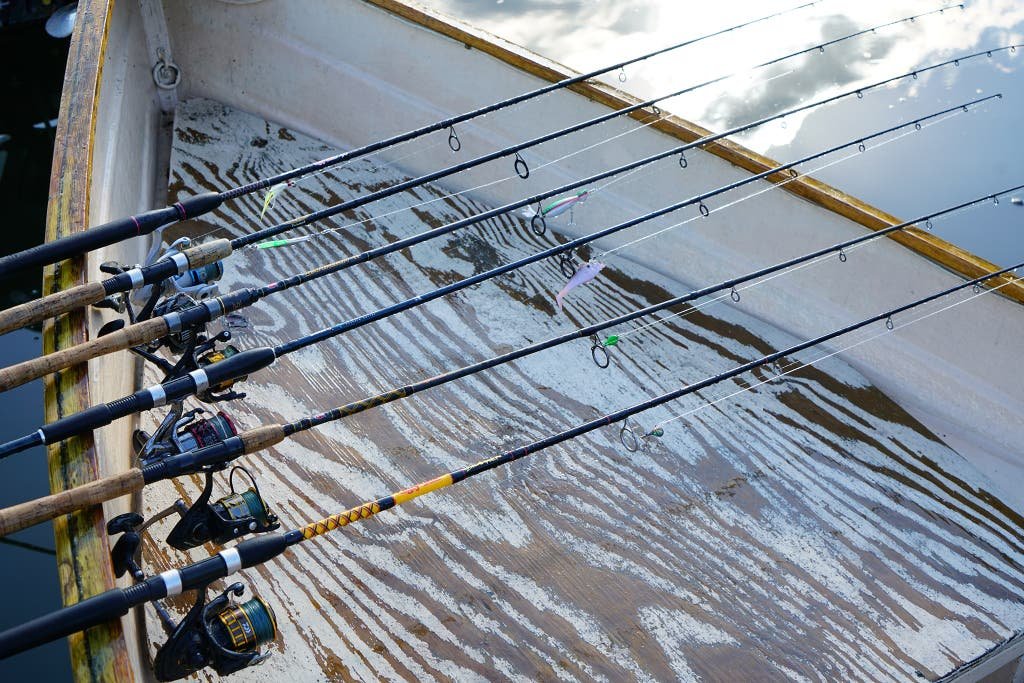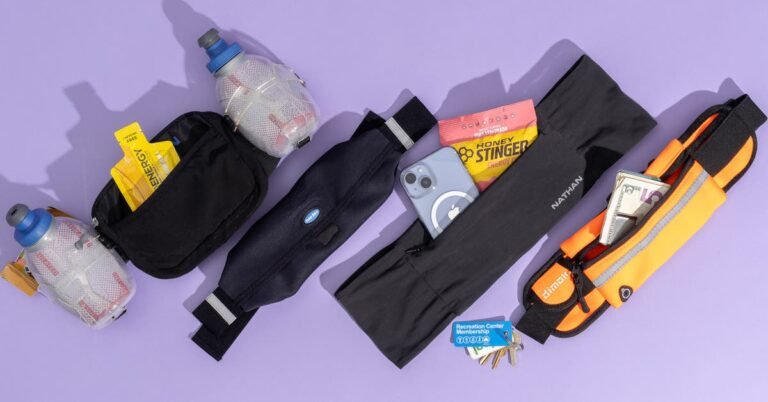
If you’re going to own only one fishing rod and reel, a spinning-rod-and-reel setup is the most versatile and the easiest to use.
Compared with a baitcasting or fly-fishing setup, for example, a spinning setup is more comfortable to use, less likely to tangle and cause headaches, and is usually easier to repair. It also requires less finesse to cast (and, generally speaking, catch fish). Think of it as the “automatic transmission” option.
In my 30-plus years of fishing, I’ve come to learn that when you’re shopping for fishing rods—as for any tool—paying a little attention to a few key features can be telling before you even pick up one. Here’s what I kept in mind when deciding which rods to test:
How much does the rod cost? At the $100 level, you’re going to get a spinning rod that can hit the waterfront as well as the bass pond and won’t give up its ghost before its time without some considerable abuse. You could easily spend $2,000 on a fishing rod if you’d like something ultralightweight or designed for a specific species you’re targeting, but our pick will get the job done almost as well (if not just as well) most of the time. Maybe someday you will want to make a big investment in your fishing gear, but it’s no place to start. Similarly, you could go cheaper, but then you’re looking at an exponentially shorter lifespan.
Does it come in multiple sizes and strengths? Most, though not all, fishing rods come in a variety of lengths, “powers” (what size fish it can handle), and stiffness or “action,” which ranges from slow (that is, soft and sensitive) to fast (stiff and maneuverable). Which you should choose will depend on where you plan to fish and what you plan to fish for. The important thing here is that you have enough options.
Will the rod itself perform well but also stand up to use? Most rods at the entry level are made from fiberglass, graphite, or a hybrid of the two. Graphite rods—or graphite-heavy hybrids—tend to be lighter and stiffer (“fast action”) but also more brittle, so you wouldn’t want to hand one to a 3-year-old. Fiberglass rods—and fiberglass-heavy hybrids—are heavier but more flexible (“slower action”) and more durable.
For a beginner, and especially one on a budget, a combination of graphite (predominantly throughout the blank, or stick part of the rod) and fiberglass (incorporated into the tip) offers a versatile package: It gives you enough stiffness to adequately manipulate a lure, while maintaining enough sensitivity for detecting small bites.
How sturdy are the guides? Another important specification you’ll want to consider is the material that makes up the guides—the loops that lead, or guide, the line from the reel to the tip of the fishing rod. Lower-end fishing rods, as well as many higher-end ones, usually feature guides made of either thin stainless steel or aluminum oxide (ceramic) frames holding cheap ceramic O-ring inserts (rings designed to protect fishing line as it whizzes in and out) that chip or corrode, and eventually fail. A bad step or fall can often trash a guide beyond functionality.

Additionally, the more pieces that make up the guide, the more potential it has to fall apart. A design with more pieces means more jointing and fastening, which usually requires glue. Since fishing rods are often exposed to sun, salt, sand, dirt, fish parts, and general wear and tear, glue is simply less than ideal, as is plastic, in novice (and less-careful) hands; a single piece of relatively rustproof metal is incomparably sturdier.
On rods in the $200 ballpark, as opposed to the $100-and-below range, you start seeing guides made of Alconite, a lightweight but sturdy ceramic; these are lighter than those made of aluminum oxide and tend to handle modern braid fishing line a bit better. They’re beyond the budget and requirements of most casual anglers, and most anglers won’t even notice the difference—I find that I don’t care one way or the other unless I’m dealing with larger fish in the surf.
How accurately are the guides placed? In any rod costing less than about $250, guide placement is done by machine, which means they’re not terribly consistent. Guide placement becomes more essential in distributing strain throughout the rod when you’re making extraordinarily long casts and fighting larger species, which is not something the average angler will put their gear through. If you do happen to be fishing big game, you’ll be wise to step up in price range, or find a good deal at a garage sale. Still, we kept an eye on this.
What is the warranty? Warranties for spinning rods can vary widely, even among brands under the same corporate umbrella. Penn, Shakespeare, and Ugly Stik are all owned by Pure Fishing, but Ugly Stik’s warranty is far better than what the other two brands offer.
Is the rod one piece, or does it break down into two or three pieces? A one-piece rod offers better stiffness and more control—fewer pieces make for fewer problems with durability and performance, although portability suffers. However, not all rods, nor all sizes of rods, come in both single-piece and multiple-piece options. For this reason, we didn’t weigh this aspect heavily in our recommendations.
What style and material is the grip? Grips are a matter of personal choice and availability. (Here, too, the rod you like, in the length and weight you need, may not come in multiple grip options, so we don’t stress grip options as much below.) If you do have a choice, I’d suggest a vinyl-wrapped handle, which won’t degrade as quickly as more common and cheaper EVA foam or cork. That said, cork offers a more traditional feel that’s hard to ignore, and if that suits you, go for it. (Pro tip: When the cork starts to crumble, simply buy some heat-shrink wrap and shore it up yourself.)

Then came the testing. I fished with lures with all of the gear, and I set everything from small minnows and crabs to 1.5-pound live baits from my skiff, catching bluefish and striped bass up to 30 pounds, with heavier, more bait-friendly setups.
I also tested the gear on smaller bottom fish, including flounder, sea bass, snapper, and tautog, as well as red drum and spotted sea trout in Charleston, South Carolina. I spent several days fishing freshwater streams and rivers for trout and smaller salmon, and a number of days fishing private ponds and lakes for largemouth bass.
I also made a point to beat these rods up in certain ways, including but not limited to neglecting to wash them after muddy and bloody saltwater outings and weaving them in and out of my cramped fishing locker in our Brooklyn basement. Our walls and stairways bear those tales, and I suspect I’ll be charged with repainting as soon as this assignment is filed.
Source link
[og_img

If you’re going to own only one fishing rod and reel, a spinning-rod-and-reel setup is the most versatile and the easiest to use.
Compared with a baitcasting or fly-fishing setup, for example, a spinning setup is more comfortable to use, less likely to tangle and cause headaches, and is usually easier to repair. It also requires less finesse to cast (and, generally speaking, catch fish). Think of it as the “automatic transmission” option.
In my 30-plus years of fishing, I’ve come to learn that when you’re shopping for fishing rods—as for any tool—paying a little attention to a few key features can be telling before you even pick up one. Here’s what I kept in mind when deciding which rods to test:
How much does the rod cost? At the $100 level, you’re going to get a spinning rod that can hit the waterfront as well as the bass pond and won’t give up its ghost before its time without some considerable abuse. You could easily spend $2,000 on a fishing rod if you’d like something ultralightweight or designed for a specific species you’re targeting, but our pick will get the job done almost as well (if not just as well) most of the time. Maybe someday you will want to make a big investment in your fishing gear, but it’s no place to start. Similarly, you could go cheaper, but then you’re looking at an exponentially shorter lifespan.
Does it come in multiple sizes and strengths? Most, though not all, fishing rods come in a variety of lengths, “powers” (what size fish it can handle), and stiffness or “action,” which ranges from slow (that is, soft and sensitive) to fast (stiff and maneuverable). Which you should choose will depend on where you plan to fish and what you plan to fish for. The important thing here is that you have enough options.
Will the rod itself perform well but also stand up to use? Most rods at the entry level are made from fiberglass, graphite, or a hybrid of the two. Graphite rods—or graphite-heavy hybrids—tend to be lighter and stiffer (“fast action”) but also more brittle, so you wouldn’t want to hand one to a 3-year-old. Fiberglass rods—and fiberglass-heavy hybrids—are heavier but more flexible (“slower action”) and more durable.
For a beginner, and especially one on a budget, a combination of graphite (predominantly throughout the blank, or stick part of the rod) and fiberglass (incorporated into the tip) offers a versatile package: It gives you enough stiffness to adequately manipulate a lure, while maintaining enough sensitivity for detecting small bites.
How sturdy are the guides? Another important specification you’ll want to consider is the material that makes up the guides—the loops that lead, or guide, the line from the reel to the tip of the fishing rod. Lower-end fishing rods, as well as many higher-end ones, usually feature guides made of either thin stainless steel or aluminum oxide (ceramic) frames holding cheap ceramic O-ring inserts (rings designed to protect fishing line as it whizzes in and out) that chip or corrode, and eventually fail. A bad step or fall can often trash a guide beyond functionality.

Additionally, the more pieces that make up the guide, the more potential it has to fall apart. A design with more pieces means more jointing and fastening, which usually requires glue. Since fishing rods are often exposed to sun, salt, sand, dirt, fish parts, and general wear and tear, glue is simply less than ideal, as is plastic, in novice (and less-careful) hands; a single piece of relatively rustproof metal is incomparably sturdier.
On rods in the $200 ballpark, as opposed to the $100-and-below range, you start seeing guides made of Alconite, a lightweight but sturdy ceramic; these are lighter than those made of aluminum oxide and tend to handle modern braid fishing line a bit better. They’re beyond the budget and requirements of most casual anglers, and most anglers won’t even notice the difference—I find that I don’t care one way or the other unless I’m dealing with larger fish in the surf.
How accurately are the guides placed? In any rod costing less than about $250, guide placement is done by machine, which means they’re not terribly consistent. Guide placement becomes more essential in distributing strain throughout the rod when you’re making extraordinarily long casts and fighting larger species, which is not something the average angler will put their gear through. If you do happen to be fishing big game, you’ll be wise to step up in price range, or find a good deal at a garage sale. Still, we kept an eye on this.
What is the warranty? Warranties for spinning rods can vary widely, even among brands under the same corporate umbrella. Penn, Shakespeare, and Ugly Stik are all owned by Pure Fishing, but Ugly Stik’s warranty is far better than what the other two brands offer.
Is the rod one piece, or does it break down into two or three pieces? A one-piece rod offers better stiffness and more control—fewer pieces make for fewer problems with durability and performance, although portability suffers. However, not all rods, nor all sizes of rods, come in both single-piece and multiple-piece options. For this reason, we didn’t weigh this aspect heavily in our recommendations.
What style and material is the grip? Grips are a matter of personal choice and availability. (Here, too, the rod you like, in the length and weight you need, may not come in multiple grip options, so we don’t stress grip options as much below.) If you do have a choice, I’d suggest a vinyl-wrapped handle, which won’t degrade as quickly as more common and cheaper EVA foam or cork. That said, cork offers a more traditional feel that’s hard to ignore, and if that suits you, go for it. (Pro tip: When the cork starts to crumble, simply buy some heat-shrink wrap and shore it up yourself.)

Then came the testing. I fished with lures with all of the gear, and I set everything from small minnows and crabs to 1.5-pound live baits from my skiff, catching bluefish and striped bass up to 30 pounds, with heavier, more bait-friendly setups.
I also tested the gear on smaller bottom fish, including flounder, sea bass, snapper, and tautog, as well as red drum and spotted sea trout in Charleston, South Carolina. I spent several days fishing freshwater streams and rivers for trout and smaller salmon, and a number of days fishing private ponds and lakes for largemouth bass.
I also made a point to beat these rods up in certain ways, including but not limited to neglecting to wash them after muddy and bloody saltwater outings and weaving them in and out of my cramped fishing locker in our Brooklyn basement. Our walls and stairways bear those tales, and I suspect I’ll be charged with repainting as soon as this assignment is filed.
The 6 Best Fishing Rod and Reel of 2025
[title_words_as_hashtags





